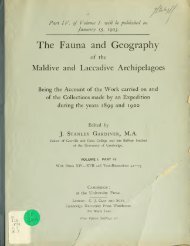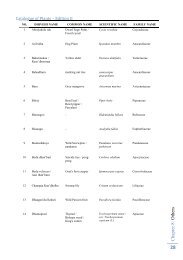692 L. A. BORRADAILE.(12) The third maxilliped with the exopodite shorter tlian the endopodite, carrying a straight,jointed flagellum directed forwards, and the endopodite narrow, with separate ischiopodite andmeropodite.(13) All the legs seven-jointed. The first three pairs chelate with normal chelae, the firstthe greatest, equal, the fourth pair simple, the fifth pair simple (?) and having its last two jointsslightly twisted so that, when the basal joints are pressed against the sides of the body, whilethe last joint of the fourth pair points downwards and backwards, that of the fifth pair pointsforwards and inwards'.(14) The gi//s many, including mastigobranchs and podobranchs on all the thoracic limbs butthe last, arthrobranchs on all but the first and last, and pleurobranchs on the last four.(15) The thoracic segments which bear the legs with distinct sterna, which are not very broad,but grow broader from before backwards, and are all fused except the last^.(16) The first pair of abdominal limbs unbranched. Those of the second to fifth segmentswith two fairly broad branches, the inner of which bears an appetidix interna (Fig. 126 c). The lastpair about as long as the telson, with broadly oval branches, across the outer of which is a suture.The internal anatomy of the various groups is not yet well enough known to allow of generalstatements being made about it.The animal was hatched in the Zoea stage, with a segmented abdomen but no limbs behindthe third maxilliped, and passed through a Mysis stage with exopodites on all the legs.The descendants of the crustacean which we have thus reconstructed fall into twosets, one <strong>com</strong>prising the Eryonidea, Scyllaridea, and Nephiopsidea, in which the abdomenis strong and well-armoured, stretched out unprotected, and used as a swimming organ bymeans of its tail-fin, and the other containing the rest of the groups, in which it has forsome reason be<strong>com</strong>e a burden and a source of danger to be protected and kept fromexposure, even though it be still shaped and used for swimming. The fii-st of these setsis on a lower and more primitive grade of organisation than the second. This is shown(1) by the abdomen, with its stout armour, overlapping terga and pleura, strong processesto clip the carapace on the first segment, broad tail-fin, and, in the Eryonidea and Scyllaridea,appendices internae. To this form of abdomen, which is always carried at length, I shallrestrict the term " macrurous." (2) by the legs, which in the Eryonidea and Nephropsideaare chelate in the first three pairs and have seven joints (except for the first pair of theNephropsidea) whereas in all other Reptantia they have only six, owing to the fusion ofthe basipodite and ischiopodite, (3) by the large number of the gills, (4) by the slenderthird maxillipeds with their long flagella directed forwards, (5) by the broad antennal scale ofthe Eryonidea and Nephropsidea. Of course some of the foregoing chai-acters are found inprimitive members of other groups, but they stamp this set of groups as a whole. Of thethree macrurous groups, the Eryonidea and Scyllaridea are more nearly allied together thaneither of them is to the Nephropsidea. They have both lost, or much reduced, their rostrum(except Palinurellus), reduced the inner lobes of the second maxilla, and fused their carapaceat the sides with the epistome, but they have kept the appendices internae. Their body' This character, though it is most prominent in the but also in the Thalassinidea, Potamobiidae and ParastacidaeAnomala and Thalassinidea and the losver Crabs, is seen to and in the prawn Stenopus. In Penaeus the anterior sternasome extent even in the more primitive groups, as the are free, but the last two are joined by secondary thickeningsPalinuridae and Potamobiidae.- A primitive feature, found not only in Boas' Anomalain the membrane between them.
MARINE CRUSTACEANS. 693shows a tendency to be flattened. The Ncphropsidea differ from them in all these respects.Between the Eryonidea and the Scyllaridea the most striking difference lies in the factthat in the former all the legs are chelate and in the latter none are so. The Eryonideaare the more primitive in keeping the antennal scale, the joint between the ischiopoditeand meropodite, and the chelae on the first three legs.aFig. 126. Limbs of A.rhis acanthus; a. second maxilla, b. first maxilliped, c. abdominal limb of the third pair.1. gnathobase or first lobe of coxopodite, 2. endopodite, B. appendix interna, 4. lobes of basipodite.In considering the second set of groups, we have first to settle whether to look upon themas of <strong>com</strong>mon descent and treat them as a whole, or whether we must find a separate pointof origin for each of them from among the Macrura. Now it may be allowed at the outsetthat there is but one character that every member of them shares with the rest. In themacrurous groups the first three pairs of legs are all alike, adapted either to seizing or tocrawling— chelate, that is, or simple. But in the modified groups we are now dealing withthe third pair is never adapted to the same end as the first. In the overwhelming majoritythe first pair are chelate or subchelate' and the third used for walking, and in the Hippidae,where the first are simple and straight, the third are hooked and flattened for burrowing orswimming. Nor i-s this point an unimportant one, for the likeness of the first three legsis a heritage from the penaeid prawns, and as such is of considerable value. Moreover itis possible to find a number of characters which, while they are not seen in every memberof the non-macrurous groups, are yet <strong>com</strong>mon in each of them, and do not occur elsewhere.These are: (1) a large gnathobase, or inner coxopoditic lobe, on the second maxilla (Fig. 126a),(2) the shape of the first maxilliped, which has a broad but shallow basipoditic lobe, whoseinner margin is in the same line with that of the coxopodite^ and a broad basal half tothe exopodite (Fig. 126 b), (3) the flagella of the maxillipeds turned inwards and curvedforwards at their ends, (4) reduction in various ways of the abdomen, (.5) the presence ofbackward prolongations of the longitudinal lines of the carapacel Since, however, numbers(3) to (5) are less strongly marked in the more primitive forms of some of the groujjs, itis doubtful whether much stress can be laid upon them.Taking it for granted, then, that the non-macrurous Decapods had a <strong>com</strong>mon, if remote,ancestor, it remains to be seen where that ancestor must be placed with regard to the1 Gebicula seems at first sight to be an exception to this,but there is on the propodite a strong tooth near the endwhich seems almost certain tu be used in the same way as theG. II." thumb" of the allied Upogebia.- Found also in at least one species of Nephropsis.' See above, footnote to p. 691.89
- Page 7 and 8:
The Fauna and Geographyof theMaldiv
- Page 9 and 10:
The Fauna and Geographyof theMaldiv
- Page 11:
CONTENTS OF VOL. II.PAKT II.Reports
- Page 14 and 15:
..590 EDGAR A. SMITH.60at3aso-73a
- Page 16 and 17:
—592 EDGAR A. SMITH.3 SC3dSaitnhe
- Page 18 and 19:
,594 EDGAR A. SMITH.3-a ao5j,Moss3
- Page 20 and 21:
.596 EDGAR A. SMITH.3oa o"?!00 >iId
- Page 22 and 23:
598 EDGAR A. SMITH.3isaa'a
- Page 24 and 25:
600 EDGAR A. SMITH.Family ACTAEONID
- Page 26 and 27:
602 EDGAR A. SMITH.23. Conus lividu
- Page 28 and 29:
604 EDGAR A. SMITH,59. Harpa ventri
- Page 30 and 31:
606 EDGAR A. SMITH.Family BUCCINIDA
- Page 32 and 33:
608 EDGAE A. SMITH.below the suture
- Page 34 and 35:
610 EDGAB, A. SMITH.135. Sistrum bi
- Page 36 and 37:
612 EDGAR A. SMITH.173. Cypraea cla
- Page 38 and 39:
614 EDGAR A. SMITH.211. Triforis gr
- Page 40 and 41:
616 EDUAK. A. SMITH.which is a para
- Page 42 and 43:
. 270.618 EDGAE A. SMITH.265. Clanc
- Page 44 and 45:
620 EDGAR A. SMITH.the shell being
- Page 46 and 47:
622 EDGAE A. SMITH.slender riblets
- Page 48 and 49:
624 EDGAR A. SMITH.330. Area (Barba
- Page 50 and 51:
626 EDGAR A. SMITH.FamilyPETRICOLID
- Page 52 and 53:
628 EDGAR A. SMITH.9. Chemnitz. Con
- Page 54 and 55:
630 EDGAR A. SMITH.Fig. 22. Natica
- Page 57:
Plate XXXVI.mii>>-*"^-^ii,.•^16./
- Page 60 and 61:
632 B. C. PUNNETT.Willeyia hisulcat
- Page 62 and 63:
634 R. C. PUNNETT.No. of Specimen.(
- Page 64 and 65:
636 R. C. PUNNETT.Internal structub
- Page 66 and 67:
638 R. C. PUNNETT.The nuchal skelet
- Page 68 and 69:
640 R. C. PUNNETT.deeply sunk posit
- Page 70 and 71:
642 E. C. PUNNETT,but no giant cell
- Page 72 and 73:
644 R. C. PUNNETT.Ptychodera flava,
- Page 74 and 75:
646 R. C. PUNNETT.(PI. XLVI. fig. 4
- Page 76 and 77:
648 R. C. PUNXETT.The racemose orga
- Page 78 and 79:
650 E. C. PUXXETT.vialdivensis proc
- Page 80 and 81:
652 R. C. PUNNETT.Collar. The muscu
- Page 82 and 83:
654 R. C. PUNNETT.Table 5.Pt. flava
- Page 84 and 85:
656 R. C. PUNNETT.whilst the oesoph
- Page 86 and 87:
658 R. C. PUNNETT.is always complet
- Page 88 and 89:
660 R. C. PUNNETT.Lastly there is a
- Page 90 and 91: 662 R. C. PUNNETT.apparently devoid
- Page 92 and 93: 664 R. C. PUNXETT.— '^^S*-!^^- Me
- Page 94 and 95: 666 R. C. PUNNETT.-Scr.— tu« HJ=
- Page 96 and 97: 668 E. C. PUNNETT.I ha\-e therefore
- Page 98 and 99: 670 K. C. PUNNETT.gonad spells incr
- Page 100 and 101: 672 R. C. PUNNETT.Table 11(continue
- Page 102 and 103: 674 R. C. PUNNETT.Table 13.Pt. flav
- Page 104 and 105: 676 R. C. PUNNETT.nlc.
- Page 106 and 107: 678 R. C. PUNNETT.Pig. 37. Ft. flav
- Page 108 and 109: 680 R. C. PUNNETT.PLATE XLV.Fig. 42
- Page 111: Fa-UTia and Geography Maldives and
- Page 115: 'Fauna and Geography Maldives aiid
- Page 119: Fauna and Geography, Maldives and L
- Page 123: Fauna and Geography, Maldives and L
- Page 127: Fauna and Geography, Maldives and L
- Page 130 and 131: (582 L. A. BORRADAILE.typical membe
- Page 132 and 133: 684 L. A. BORRADAILE.arrangement is
- Page 134 and 135: :686 L. A. BORRADAILE.Subfamily Aca
- Page 136 and 137: 688 L- A. BORRADAILE.gaping. The sp
- Page 138 and 139: :690 L. A. BORRADAILE.26. Lambrus (
- Page 142 and 143: 694 L. A. BORRADAILE.macrurous grou
- Page 144 and 145: :696 L. A. BORRADAILE.the whole, ho
- Page 146 and 147: 698 L. A. BORRADAILE.2. 6th alxloni
- Page 149: Fauna and Geography, Maldives and L
- Page 156 and 157: 7. Lepidoptera ... .;...... 123Volu
- Page 158: It was supposed that the whole work






